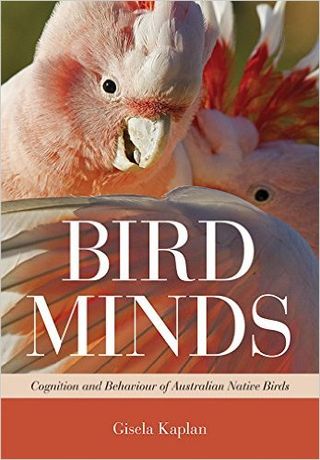Animal Behavior
Bird Minds: An Outstanding Book About Australian Natives
Gisela Kaplan's new book is a must read for researchers and amateur naturalists
Posted April 4, 2016
Gisela Kaplan is a research professor in animal behavior at the University of New England in Armidale (New South Wales) and a walking encyclopedia of knowledge about birds and other fascinating nonhuman animals (animals). Her new book called Bird Minds: Cognition and Behaviour of Australian Native Birds is a clear example of the depth and breadth of her knowledge, and I can't recommend it too highly, not only for those people interested in birds, but also for those who want to know about some of the basic principles of evolutionary biology, ecology, conservation, and animal behavior. And, indeed, the wide variety of Australian birds about whom Dr. Kaplan writes is, in and of itself, a good reason to read this book because they've evolved the most sophisticated cognitive skills and also display a wide range of emotions. They've also had to learn to survive in diverse human-dominated ecosystems. All in all, as Dr. Kaplan notes, Australia is a hotspot for cooperative behaviour in birds." (p. 8) But, there is much more in this comprehensive book.

The book's description reads as follows:
Recent published papers in the field of neurobiology and neuropsychology have dramatically changed our thinking about the avian brain and behavioral potential of birds, especially in the areas of learning, memory, plasticity, and in the cognitive and emotional domains. Bird Minds provides a fresh view of the behavior of Australian native avifauna, presenting a portrait of cognitive well-equipped species, which is somewhat removed from the traditional image of birds as fluttering, colorful ornaments that tend to move like automata.
The book will focus on the specific abilities of Australian birds, examining why they have had to find – largely cognitive – ways of adapting to difficult conditions. The demands of the Australian environment have led to the development of cognitively complex processes that are unique in the world, including complex behaviors such as grieving, deception, problem solving and the use of tools. Many Australian birds cooperate and defend each other, and exceptional ones go fishing by throwing breadcrumbs in the water, extract poisonous parts from prey and use tools to crack open eggshells and mussels.
A glance at the table of contents will show just how much ground is covered in Bird Minds. It's somewhat staggering, and readers will find in-depth discussions of brains and behavior (bigger is not necessarily better, and there's a downside to large brains, p. 25), foraging strategies, tool use (Australian tool users are among the best), play behavior, mimicry, imitation, and cognition, intentional communication, and how these and other birds handle abstract concepts. The summary tables are goldmines of information and in-depth accounts of the wide range of behavioral styles and adaptations that are wonderful examples of how diverse species have adapted to island life and to diverse habitats where there are non-too-friendly humans. The images are also excellent and educational.
Among my favorite discussions, and there are many, is Dr. Kaplan's summary of the behavior of cooperative white-winged choughs (pp. 188-189). She notes that these highly innovative birds live in cohesive groups but they also "can turn into street gangs, sending out scouts to destroy magpie-lark nests and even nests of other choughs in their own group. They steal youngsters from other groups and there are helpers at the nest that pretend to help when they do not." Sounds like some mammals I know including members of my own species!
She also notes (p. 188) that for birds in the parvorder called Corvida, "we also find that cooperative behaviour dominates and, at the same time, it also contains the largest number of thieves and cheats -- be this among the bowerbird juveniles stealing building material from each other, while cheating on partners is raised to an art form in fairy-wrens by having secret male meeting areas for extra-pair copulations."
I'm not an expert in avian ethology, and in numerous instances I found myself substituting a mammal with whom I'm more familiar. Nonetheless, the take-home message for me is that the birds about whom Dr. Kaplan writes are, in many ways, as "smart" and emotional as mammals. This might not be all that surprising to researchers, but I'm sure that many "amateur" birders and naturalists will see that being a birdbrain is just fine! Indeed, I'll be more careful calling someone a birdbrain when I'm trying to fault them.
I highly recommend Dr. Kaplan's most recent gem (along with her other books). Bird Minds would be an excellent book for researchers, advanced undergraduate and graduate courses, and for others who just want to know about the fascinating animals with whom we share our magnificent world.
Marc Bekoff's latest books are Jasper's Story: Saving Moon Bears (with Jill Robinson), Ignoring Nature No More: The Case for Compassionate Conservation, Why Dogs Hump and Bees Get Depressed: The Fascinating Science of Animal Intelligence, Emotions, Friendship, and Conservation, Rewilding Our Hearts: Building Pathways of Compassion and Coexistence, and The Jane Effect: Celebrating Jane Goodall (edited with Dale Peterson). (Homepage: marcbekoff.com; @MarcBekoff)


